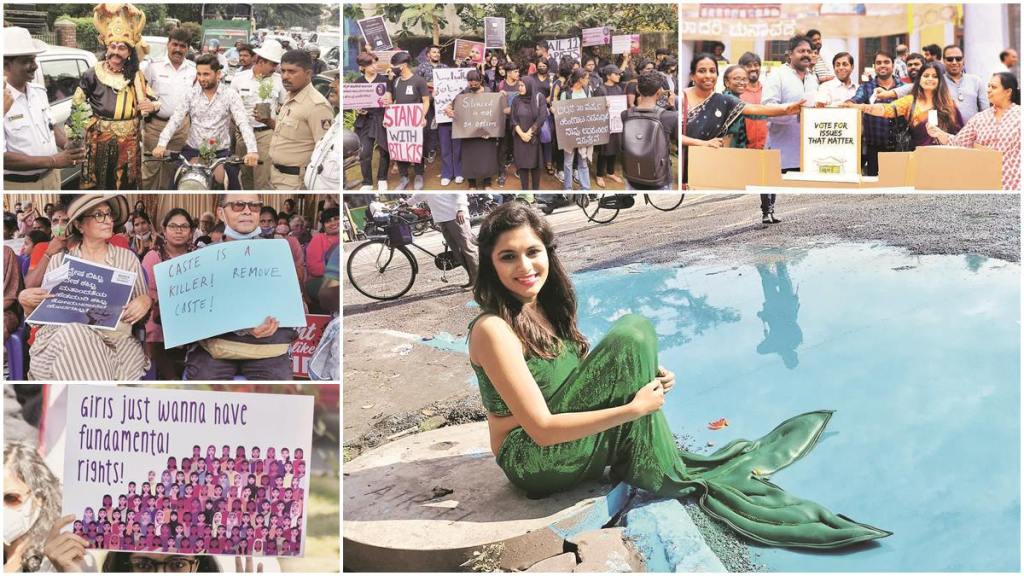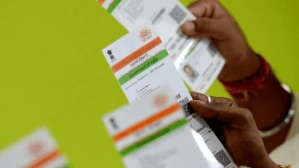Bengaluru rang in a special Diwali this year, unique from the rest of the country. A bunch of protesters, including MLAs, sat around potholes, placed flowers and lamps, and burst crackers near them, urging the government to improve the pathetic road conditions that have now become synonymous with the Silicon Valley of India.
Not just potholes, Bengalureans find innovative ways to draw the attention of the authorities and the media towards their trees, the betterment of public transport, the revival of lakes or just about everything that will help in making their city a better place to live in. From civic issues to environmental causes, the capital of Karnataka has become home to a new-age civil society movement, with people from different social backgrounds and age groups joining hands as they realise the strength in unity and turn conversations into action.
However, protests are not a new phenomenon in Bengaluru. Their history goes a long way.
It was in 2016. Roads were lined up with residents who locked hands with each other in a human chain. There were about 8,000 of them, uniting for a single cause in a never-seen-before show of strength. Their thoughts were fixed on the same goal and their voices echoed a single demand—‘steel flyover beda’ or in other words, ‘say no to steel flyover’.
The campaign was a turning point, a stark example of the functioning of democracy and dissent, and how the unity and strength of people halted even the biggest of projects.
As the human-chain protest made headlines and forced the government officials to bend to the people’s demands, the project was scrapped in 2017. The controversial 6.9-km steel flyover that would have cost Rs 2,100 crore and was being helmed by the Bangalore Development Authority (BDA) would have required the chopping of 812 trees to connect Bengaluru’s Basaveshwara circle with Hebbal.
Among the several citizens groups that came forward, one prominent voice was that of Citizens for Bengaluru (CfB). The citizen’s group later went on to establish ward committees to execute issues at ward levels rather than depending on higher authorities to solve local problems.
One of the co-founders of the group, Srinivas Alavilli, a techie by profession, says that when he returned to India from the US in 2007, he wanted to use his voice against corruption and get involved in local politics. When that didn’t work out, he became a crucial part of India Against Corruption, the anti-corruption movement of 2011-12. When the steel flyover was announced, they organised themselves to mobilise people to stand up. “Some came against corruption, and some didn’t want trees to be cut. It was overall a very apolitical and straightforward protest wherein people joined, held hands and went,” says Alavilli, who is now the head of civic participation in Janaagraha Centre for Citizenship and Democracy, a non-profit organisation, where he trains newly elected councilors about their roles.
The movement is reflective of the society that Bengaluru is—closely attached to its roots, vocal for its causes and active in bringing about a change. Thousands, for instance, turned up for the tractor parade in Bengaluru in solidarity with the Delhi farmers in 2021 during the protests over the farm laws.
When asked what makes Bengaluru an active city when it comes to public participation in governance and issues relating to policy making, environment and social causes, Alavilli feels the governments have always been very encouraging of public partnerships. “If your basic necessities are met, you will voice out opinions on other important civic matters and in Bengaluru, people have global exposure. There is an academic culture here, and an understanding of law and environment.
People here also love their trees. I have revived two lakes and in the last decade, I have seen at least 50 lakes being revived. The local media is also receptive to citizen movements,” he says.
According to him, the organisation of citizens into residents welfare associations (RWAs), apartment federations, ward committees and groups, and the strong online presence further help the cause.
Tara Krishnaswamy, who was also a co-founder of Citizens for Bengaluru and the founder of Shakti, a non-partisan group of citizens campaigning for more women MLAs and MPs, says the reason Bengaluru is active in environmental and social issues is that it has an identity of being a ‘garden city’, and a ‘city of lakes’. “It is known for its pleasant weather and lakes and trees and Bengalureans have a pride in their strong identity. That pride is pricked when Bengaluru is affected from tree felling or any other issue,” she says.
An example of the city’s love for its trees was witnessed when last year, citizen’s protests stalled the Turahalli park project that would have led to the construction of a tree park within the 400 acres of Turahalli Minor Forest area.
On why she chose to fight for more women in politics, she says India is one of those places where, if we don’t deliberately close our eyes, we’ll see inequality and injustice all around and a huge gap within society. “From the mass molestation that happened (in 2016 new year’s eve) to the discrimination the northeastern women face, the city is not equal for men and women by any measure. Politics is one of those areas, where we see a dramatic difference between the percentage of men and women elected,” she adds.
Priya Chetty-Rajagopal, who was also a part of the ‘Steel Flyover Beda’ protest and is one of the founding members of Heritage Beku, Bengaluru’s first citizen advocacy initiative that works towards preserving the city’s architectural and natural heritage, believes it was her love for Bengaluru and realisation that one has to work with reality and with eyes wide open that led her to ‘activism’. “I was also thrown into ‘activism’ when the Steel Flyover Beda campaign started. It was a learning experience. In Bengaluru, we ask questions and catalyse rather than just demand answers,” says Chetty-Rajagopal, who is also the managing partner of Multiversal Advisory, an executive search firm headquartered in Bengaluru. She adds that a democratic space must be ‘co-owned’.
Advocate and social activist Vinay Sreenivasa adds that Bengaluru has had a history of activism in the last three to four decades and the city’s cosmopolitan nature also helps in giving it a voice.
This protest, that protest
It is not that Bengalureans only protest against flyovers. But they also take to the streets for bringing alternatives that would prove to be more public and environment friendly and economical. Bengaluru’s ‘Chuku Buku Beku’ campaign of 2017 has been one such that was successful in demanding a suburban rail connectivity within the city so that the office goers could take a train instead of long rides. This was also being looked at as a solution to solve the city’s impending traffic woes.
In July 2018, Bengaluru Traffic Police hired a ‘Yamaraja’ to remind motorists of following traffic rules. Theatre artist Veeresh was roped in and dressed up as the ‘god of death’. In amusing videos that went viral, he was seen chasing motorists who flouted the rules and even riding behind some to symbolise how death follows those who ride carelessly and break rules.
Exactly four years later in July 2022, ‘Yamaraja’ made an appearance once again on Bengaluru streets in Anjanapura area as this time he protested against bad roads. In the video that again went viral, the man dressed as Yama can be seen standing with a buffalo (known to be Lord Yamaraja’s ride) as the people around him shout slogans for bad roads.
Bengaluru’s potholed roads, in fact, have attracted the ire of a number of residents who have taken creative paths to express their concerns while also making the government officials take note of the road conditions.
Citizen’s group Malleswaram Social, for instance, is known for unique, satirical and engaging methods to draw attention to the bad condition of roads. In 2018, two women from the group made a video ‘Bharatnatya Saaku, #FootPathBeku’ in which they can be seen performing Bharatnatyam on the broken footpaths of Malleswaram area as other male members of the group play musical instruments.
In March this year, a special ‘pothole puje’ was performed by Malleswaram residents on potholes in the locality to highlight the poor condition of roads as they are dug up every now and then for civic works. In the video, the residents can be seen holding banners and surrounding a ‘priest’ as he performs the puja on the pothole.
As if this was not entertaining enough, artist Baadal Nanjundaswamy, who is widely popular for his street art and 3D paintings, has managed to bring ‘crocodiles’ on roads and the ‘moon on Earth’ to highlight the condition of bad roads. One of his most famous campaigns till date remains the crocodile art installation on Sulthanpalya main road in north Bengaluru. He painted a giant pothole and placed a life-sized fibre crocodile in it to make it look life-like. This was done to attract the attention of the city’s administrative body Bruhat Bengaluru Mahanagara Palike (BBMP) that’s responsible for the maintenance of the roads.
Also Read: How do we play our part?
Four years later in 2019, Nanjundaswamy executed another of his creative masterpieces when he did a moonwalk of pothole-riddled roads. In the video that was shot, a close-up of the artist wearing a space suit and walking on the ‘craters’ of the moon was seen. As one thought that it was the video of an astronaut, the camera zoomed out to show the ‘astronaut’ walking on Tunganagar main road with crater-sized potholes as vehicles went by. As interesting as the concept was, it went viral quickly and woke the BBMP from its slumber.
Speaking with FE, Nanjundaswamy says he puts in efforts to “make things appropriate.” “I analyse the location and the condition of the place then I always look after the current affairs which I think add a loud voice to the issue and art,” he says, adding that bad administration led him to think of creative ways of bringing things to light.
Public participation is such that even top authorities call in citizen groups and the general public for consultation before implementing certain projects. The bus priority lane, for instance, which was being implemented by Bengaluru Metropolitan Transport Corporation (BMTC), had several rounds of public discussions on its implementation and the routes between its top officials and citizen groups.
BMTC director (IT) AV Surya Sen says, “BMTC is one of the most important services in Bengaluru as we operate more than 6,000 buses every day and transport more than 35 lakh people. We have 30,000 employees as part of the Bengaluru city ecosystem. So, we have to take care of both the employees and the public. There have been protests in the past, too, for labour welfare, employees and public transportation.”
According to Sen, public transportation is very important for sustainable development goals, climate change and is an eco-friendly mode. “People are getting more and more aware every day and becoming responsible. Public transport is economically viable. We all know fossil fuel-driven vehicles are getting expensive and if not given an economic and sustainable service, people will protest and ask. BMTC is inclusive of participation of the public. Even for specific routes and services we have specific public groups in order to have better public participation,” he adds.
What’s noteworthy is that dissent in the city is oblivious to class. In July this year, pourakarmikas or street sweepers went on a four-day protest to demand that the state government regularise the services of those pourakarmikas who work on contract. The protest was called off after the government gave them written assurances of the same. Similarly, auto drivers in the city have been protesting as the crackdown on overcharging of fares by taxi aggregators continues. This comes after the transport department directed taxi aggregators Ola, Uber and Rapido on October 6 to immediately stop auto services as they were found to be collecting excessive fares from passengers.
Bengaluru’s transgender activists, too, have had a strong voice in fighting for their rights. Transgender activist Akkai Padmashali is widely known for her work in activism and received the Rajyotsava Prashasti, the second highest civilian honour of the state of Karnataka as well as an honorary doctorate from the Indian Virtual University for Peace and Education.
Clamping down dissent
However, the city, always raging with protests, has also been put to silence in the past. When the High Court of Karnataka directed the state government to restrict all rallies and protests only to Freedom Park, the city felt that its voice was being muffled. The step was taken to avoid the impact on traffic during peak hours as people protest in huge numbers.
According to the regulations framed under Licensing and Regulation of Protests, Demonstrations and Protest Marches (Bengaluru City) Order, 2021, issued in exercise of powers under Section 31 (O) of Karnataka Police Act, 1963, all protests in the city will be restricted to Freedom Park. This is the case in few other Indian cities as well. For instance, Delhiites protest at Jantar Mantar.
Advocate Vinay Sreenivasa criticises the decision to restrict protests to Freedom Park and says that it violates the rights to freedom of speech and assembly.
Leo Saldanha, founding trustee and full-time coordinator of Environmental Support Group (ESG), an independent, not-for-profit non-governmental organisation, feels that earlier one would just go out and protest but that has changed post this judgment.
“There was a climate of openness earlier. Now permissions are at times denied for a lot of protests,” he says while making a case for freedom of speech. He has been observing a culture of protests in the city since the last three decades and grew up in a politically active neighbourhood.








